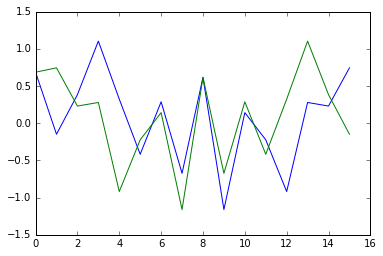Maximilian Matthé's answer has all the necessary information, viz.,
$$y[n]=x[-n \mod N]=x[N-n], ~ n=0, \ldots, N-1.$$
This corresponds to the continuous-time result which says that taking the Fourier Transform of $x(t)$ twice gives us $x(-t)$ -- the time-reversal of $x(t)$ -- a result that I used to illustrate in the "good old days" when presentations used viewgraphs by taking a viewgraph showing $x(t)$ off the projector, flipping it over, and putting it back on the projector
while saying "This is what $x(-t)$ looks like". But this brings up a subtle difference between the continuous-time case and the discrete-time case, namely, that
if we look at the DFT as a linear transformation mapping a vector $\mathbf x$ to a vector $\mathbf X$:
\begin{align}\operatorname{DFT}(\mathbf x) &= \mathbf X\\
&\text{i.e.}\\
\operatorname{DFT}\bigr(\left(x[0], x[1], \cdots, x[N-1]\right)\bigr)
&= \left(X[0], X[1], \cdots, X[N-1]\right),\end{align}
then
$$\operatorname{DFT}\bigr(\operatorname{DFT}
\big(\left(x[0], x[1], \cdots, x[N-1]\right)\big) \bigr)
= \left(x[0], x[N-1], x[N-2] \cdots, x[2], x[1]\right)$$
and not $\left(x[N-1], x[N-2] \cdots, x[2], x[1], x[0]\right)$
which is what one would get by writing the entries of $\mathbf x$ in reverse order. Just as well, because flipping over a viewgraph on which is written $\left(x[0], x[1], \cdots, x[N-1]\right)$ results in an
unreadable mess that is also wrong to boot!
The $0$-th bin is a fixed point of the transformation
$\mathbf x \to \operatorname{DFT}\bigr(\operatorname{DFT}
\big(\mathbf x\big)\bigr)$; it has the same value after taking the DFT of the DFT of $\mathbf x$. When $N$ is an even number, $N/2$ is also a fixed point of the transformation, and has the same value after taking the DFT twice.

